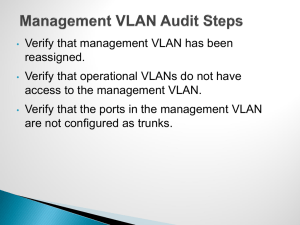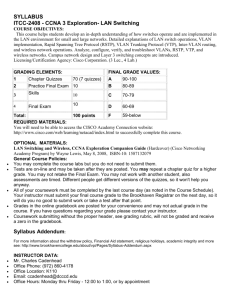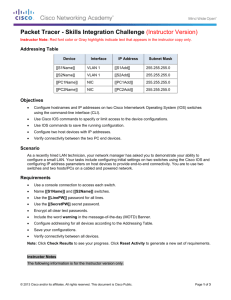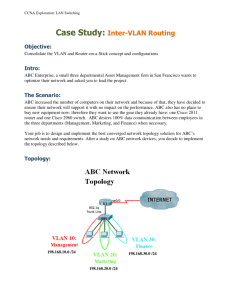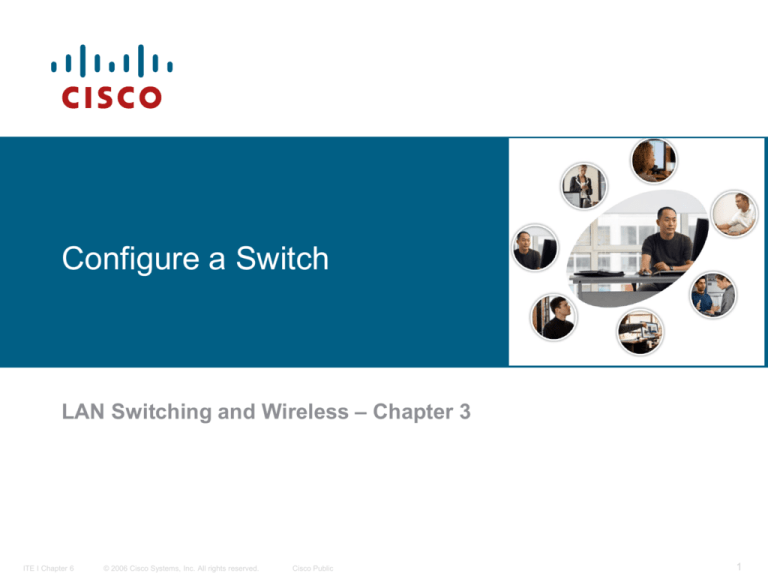
Configure a Switch
LAN Switching and Wireless – Chapter 3
ITE I Chapter 6
© 2006 Cisco Systems, Inc. All rights reserved.
Cisco Public
1
VLANs
A VLAN allows a network administrator to create groups of logically
networked devices that act as if they are on their own independent
network, even if they share a common infrastructure with other
VLANs.
VLANs allow the network administrator to implement access and
security policies to particular groups of users
VLANs allow multiple IP networks and subnets to exist on the
same switched network.
For computers to communicate on the same VLAN, each must
have an IP address and a subnet mask that is consistent for that
VLAN.
The switch has to be configured with the VLAN and each port in
the VLAN must be assigned to the VLAN.
ITE 1 Chapter 6
© 2006 Cisco Systems, Inc. All rights reserved.
Cisco Public
2
Benefits of VLANs
The primary benefits of using VLANs are as follows:
Security - Groups that have sensitive data are separated from the
rest of the network, decreasing the chances of confidential
information breaches.
Cost reduction - Cost savings result from less need for expensive
network upgrades and more efficient use of existing bandwidth and
uplinks.
Higher performance - Dividing flat Layer 2 networks into multiple
logical workgroups (broadcast domains) reduces unnecessary
traffic on the network and boosts performance.
Broadcast storm mitigation - Dividing a network into VLANs
reduces the number of devices that may participate in a broadcast
storm.
ITE 1 Chapter 6
© 2006 Cisco Systems, Inc. All rights reserved.
Cisco Public
3
Conti…
Improved IT staff efficiency -VLANs make it easier to manage
the network because users with similar network requirements
share the same VLAN. When you provision a new switch, all the
policies and procedures already configured for the particular VLAN
are implemented when the ports are assigned.
ITE 1 Chapter 6
© 2006 Cisco Systems, Inc. All rights reserved.
Cisco Public
4
VLAN Ranges
Normal Range VLANs
Used in small- and medium-sized business and enterprise
networks.
Identified by a VLAN ID between 1 and 1005.
IDs 1002 through 1005 are reserved for Token Ring and FDDI
VLANs.
Configurations are stored within a VLAN database file, called
vlan.dat. The vlan.dat file is located in the flash memory of the
switch.
ITE 1 Chapter 6
© 2006 Cisco Systems, Inc. All rights reserved.
Cisco Public
5
Conti…
Extended Range VLANs
Enable service providers to extend their infrastructure to a greater
number of customers. Some global enterprises could be large
enough to need extended range VLAN IDs.
Are identified by a VLAN ID between 1006 and 4094.
Support fewer VLAN features than normal range VLANs.
Are saved in the running configuration file.
VTP does not learn extended range VLANs.
ITE 1 Chapter 6
© 2006 Cisco Systems, Inc. All rights reserved.
Cisco Public
6
Conti…
Number of VLANs per Switch
One Cisco Catalyst 2960 switch can support up to 255
normal range and extended range VLANs, although the
number configured affects the performance of the
switch hardware. Because an enterprise network may
need a switch with a lot of ports,
ITE 1 Chapter 6
© 2006 Cisco Systems, Inc. All rights reserved.
Cisco Public
7
Conti…
Duplex settings
Here are two types of duplex settings used for communications on
an Ethernet network:
Half Duplex
Unidirectional data flow
Higher potential for collision
Hub connectivity
Higher
ITE 1 Chapter 6
© 2006 Cisco Systems, Inc. All rights reserved.
Cisco Public
8
Types of VLANs
Data VLAN- A data VLAN is a VLAN that is configured to carry
only user-generated traffic. A data VLAN is sometimes referred to
as a user VLAN.
Default VLAN-All switch ports become a member of the default
VLAN after the initial boot up of the switch. The default VLAN for
Cisco switches is VLAN 1.
Native VLAN-The 802.1Q trunk port places untagged traffic on
the native VLAN. Native VLANs are set out in the IEEE 802.1Q
specification to maintain backward compatibility with untagged
traffic common to legacy LAN scenarios.
Management- VLANA management VLAN is any VLAN you
configure to access the management capabilities of a switch.
VLAN 1 would serve as the management VLAN if you did not
proactively define a unique VLAN to serve as the management
VLAN.
ITE 1 Chapter 6
© 2006 Cisco Systems, Inc. All rights reserved.
Cisco Public
9
Conti…
Voice VLANs - It is easy to appreciate why a separate VLAN is
needed to support Voice over IP (VoIP). Imagine you are receiving
an emergency call and suddenly the quality of the transmission
degrades so much you cannot understand what the caller is
saying. VoIP traffic requires:
Assured bandwidth to ensure voice quality
Transmission priority over other types of network traffic
Ability to be routed around congested areas on the network
Delay of less than 150 milliseconds (ms) across the network
Note- The details of how to configure a network to support VoIP
are beyond the scope of the course
ITE 1 Chapter 6
© 2006 Cisco Systems, Inc. All rights reserved.
Cisco Public
10
Conti…
A Cisco Phone is a Switch
The Cisco IP Phone contains an integrated three-port 10/100
switch as shown in the Figure. The ports provide dedicated
connections to these devices:
Port 1 connects to the switch or other voice-over-IP (VoIP) device.
Port 2 is an internal 10/100 interface that carries the IP phone
traffic.
Port 3 (access port) connects to a PC or other device.
Note: Communication between the switch and IP phone is
facilitated by the CDP protocol.
ITE 1 Chapter 6
© 2006 Cisco Systems, Inc. All rights reserved.
Cisco Public
11
Network Traffic Types
Network Management and Control Traffic
Many different types of network management and control traffic can
be present on the network, such as Cisco Discovery Protocol
(CDP) updates, Simple Network Management Protocol (SNMP)
traffic, and Remote Monitoring (RMON) traffic.
IP Telephony
The types of IP telephony traffic are signaling traffic and voice
traffic. Signaling traffic is, responsible for call setup, progress, and
teardown, and traverses the network end to end. The other type of
telephony traffic consists of data packets of the actual voice
conversation.
ITE 1 Chapter 6
© 2006 Cisco Systems, Inc. All rights reserved.
Cisco Public
12
Conti…
IP Multicast
IP multicast traffic is sent from a particular source address to a
multicast group that is identified by a single IP and MAC
destination-group address pair. Examples of applications that
generate this type of traffic are Cisco IP/TV broadcasts.
Normal Data
Normal data traffic is related to file creation and storage, print
services, e-mail database access, and other shared network
applications that are common to business uses. VLANs are a
natural solution for this type of traffic
ITE 1 Chapter 6
© 2006 Cisco Systems, Inc. All rights reserved.
Cisco Public
13
Conti…
Scavenger Class
The Scavenger class is intended to provide less-than best-effort
services to certain applications. Applications assigned to this class
have little or no contribution to the organizational objectives of the
enterprise and are typically entertainment oriented in nature.
These include peer-to-peer media-sharing applications (KaZaa,
Morpheus, Groekster, Napster, iMesh, and so on), gaming
applications (Doom, Quake, Unreal Tournament, and so on), and
any entertainment video applications
ITE 1 Chapter 6
© 2006 Cisco Systems, Inc. All rights reserved.
Cisco Public
14
Switch port membership mode
VLAN Switch Port Modes
Static VLAN - Ports on a switch are manually assigned to a VLAN.
Static VLANs are configured using the Cisco CLI.
Dynamic VLAN - This mode is not widely used in production
networks and is not explored in this course. However, it is useful to
know what a dynamic VLAN is. A dynamic port VLAN membership
is configured using a special server called a VLAN Membership
Policy Server (VMPS). With the VMPS, you assign switch ports to
VLANs dynamically, based on the source MAC address of the
device connected to the port.
ITE 1 Chapter 6
© 2006 Cisco Systems, Inc. All rights reserved.
Cisco Public
15
Conti…
Voice VLAN – Configuration
The configuration command mls qos trust cos ensures that voice
traffic is identified as priority traffic.
The switchport voice vlan 150 command identifies VLAN 150 as
the voice VLAN. And Switchport mode access
Static VLAN configuration
Interface fastethernet 0/8
Switchport mode access
Switchport access vlan 20
ITE 1 Chapter 6
© 2006 Cisco Systems, Inc. All rights reserved.
Cisco Public
16
Conti…
Native VLAN configuration
Interface fastyethernet 0/12
Switchport mode trunk
Switchport trunk native vlan 99
ITE 1 Chapter 6
© 2006 Cisco Systems, Inc. All rights reserved.
Cisco Public
17
Controlling broadcast domain with VLANs
Intra-VLAN Communication--PC1, wants to communicate with
another device, PC4. PC1 and PC4 are both in VLAN 10.
Communicating with a device in the same VLAN is called intraVLAN communication.
Inter-VLAN Communication
PC1 in VLAN 10 wants to communicate with PC5 in VLAN 20.
Communicating with a device in another VLAN is called interVLAN communication.
ITE 1 Chapter 6
© 2006 Cisco Systems, Inc. All rights reserved.
Cisco Public
18
Layer 3 Functionality (Not in course)
SVI (switch virtual interface)
SVI is a logical interface configured for a specific VLAN. By default, an SVI
is created for the default VLAN (VLAN 1) to permit remote switch
administration.
Layer 3 Forwarding
A Layer 3 switch has the ability to route transmissions between VLANs.
The procedure is the same as described for the inter-VLAN
communication using a separate router, except that the SVIs act as the
router interfaces for routing the data between VLANs. The animation
describes this process.
ITE 1 Chapter 6
© 2006 Cisco Systems, Inc. All rights reserved.
Cisco Public
19
VLAN Trunks
A trunk is a point-to-point link between two network devices that
carries more than one VLAN.
What Problem Does a Trunk Solve?
Each time a new subnetwork is considered, a new link is needed
for each switch in the network in absence of trunk. So it preserves
switch ports
802.1Q Frame Tagging
The VLAN tag field consists of an EtherType field, a tag control
information field,and the FCS field.
ITE 1 Chapter 6
© 2006 Cisco Systems, Inc. All rights reserved.
Cisco Public
20
Conti…
Tag control information field
The tag control information field contains:
3 bits of user priority - Used by the 802.1p standard, which specifies
how to provide expedited transmission of Layer 2 frames. A description of
the IEEE 802.1p is beyond the scope of this course; however, you learned
a little about it earlier in the discussion on voice VLANs.
1 bit of Canonical Format Identifier (CFI) - Enables Token Ring frames
to be carried across Ethernet links easily.
12 bits of VLAN ID (VID) - VLAN identification numbers; supports up to
4096 VLAN IDs.
FCS field
After the switch inserts the EtherType and tag control information
fields, it recalculates the FCS values and inserts it into the frame.
ITE 1 Chapter 6
© 2006 Cisco Systems, Inc. All rights reserved.
Cisco Public
21
Conti…
ISL
In an ISL trunk port, all received packets are expected to be
encapsulated with an ISL header, and all transmitted packets are
sent with an ISL header. Native (non-tagged) frames received from
an ISL trunk port are dropped. ISL is no longer a recommended
trunk port mode, and it is not supported on a number of Cisco
switches.
ITE 1 Chapter 6
© 2006 Cisco Systems, Inc. All rights reserved.
Cisco Public
22
Dynamic trunking protocol
Cisco Proprietary
DTP manages trunk negotiation only if the port on the other switch
is configured in a trunk mode that supports DTP.
Trunking Modes
On (default)-switchport mode trunk.
Dynamic auto- switchport mode dynamic auto.
After a DTP negotiation, the local port ends up in trunking state
only if the remote port trunk mode has been configured to be on or
desirable. If both ports on the switches are set to auto, they do not
negotiate to be in a trunking state.
Dynamic desirable-switchport mode dynamic desirable.
If the local port detects that the remote has been configured in on,
desirable, or auto mode, the local port ends up in trunking state.
ITE 1 Chapter 6
© 2006 Cisco Systems, Inc. All rights reserved.
Cisco Public
23
Conti…
Turn off DTP
You can turn off DTP for the trunk so that the local port
does not send out DTP frames to the remote port. Use
the command switchport nonegotiate. The local port
is then considered to be in an unconditional trunking
state. Use this feature when you need to configure a
trunk with a switch from another switch vendor.
ITE 1 Chapter 6
© 2006 Cisco Systems, Inc. All rights reserved.
Cisco Public
24
Configuring VLAN and Trunks
Create VLANs
Assign switch ports to VLANs statically
Verity VLAN configuration
Enable trunking on the inter switch connections
Verify trunk configuration
ITE 1 Chapter 6
© 2006 Cisco Systems, Inc. All rights reserved.
Cisco Public
25
Conti…
Step 1
Configure terminal
Vlan 20
Name student
End
Step 2
Interface fastethernet 0/13
Switchport mode access
Switchport mode vlan 20
End…… show interface vlan 20
Step 3
Show vlan brief-----show vlan name student
ITE 1 Chapter 6
© 2006 Cisco Systems, Inc. All rights reserved.
Cisco Public
26
Conti…
Delete vlan
No vlan 20
Delete flash:vlan.dat
Configuring 802.1 Q
switchport mode trunk
Verify trunk configuration
Show interface fa0/13 switchport
ITE 1 Chapter 6
© 2006 Cisco Systems, Inc. All rights reserved.
Cisco Public
27
Common Problems with Trunks
Native VLAN mismatches - Trunk ports are configured with
different native VLANs, for example, if one port has defined VLAN
99 as the native VLAN and the other trunk port has defined VLAN
100 as the native VLAN.
Trunk mode mismatches - One trunk port is configured with trunk
mode "off" and the other with trunk mode "on".
VLANs and IP Subnets - End user devices configured with
incorrect IP addresses will not have network connectivity.
Allowed VLANs on trunks - The list of allowed VLANs on a trunk
has not been updated with the current VLAN trunking
requirements.( switchport trunk allowed vlan 10,20,99 )
ITE 1 Chapter 6
© 2006 Cisco Systems, Inc. All rights reserved.
Cisco Public
28
ITE 1 Chapter 6
© 2006 Cisco Systems, Inc. All rights reserved.
Cisco Public
29



